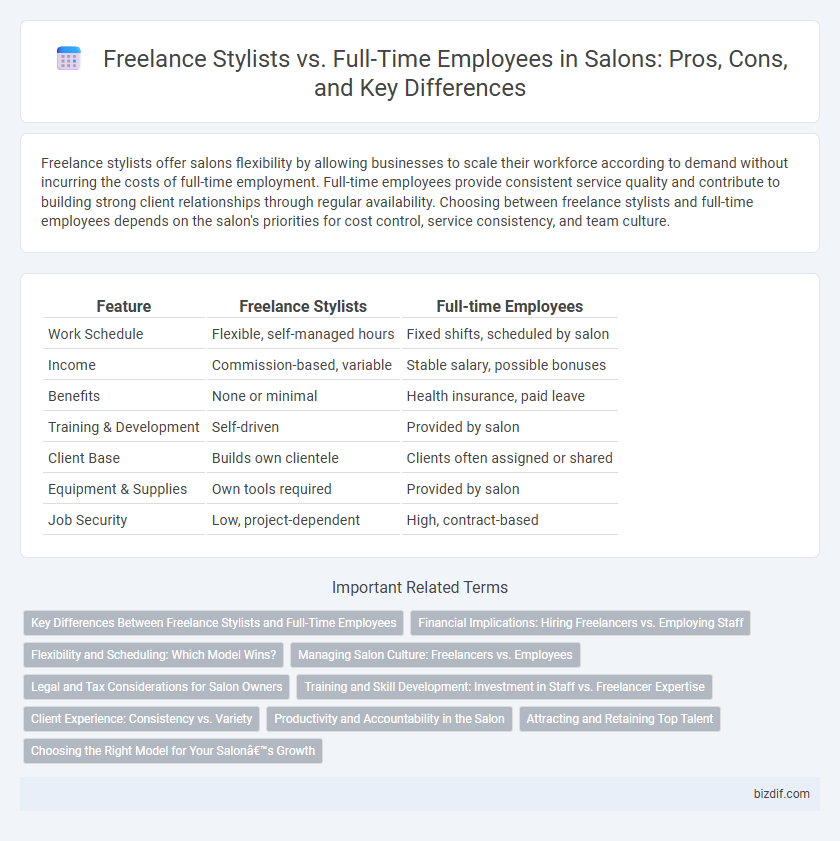Freelance stylists offer salons flexibility by allowing businesses to scale their workforce according to demand without incurring the costs of full-time employment. Full-time employees provide consistent service quality and contribute to building strong client relationships through regular availability. Choosing between freelance stylists and full-time employees depends on the salon's priorities for cost control, service consistency, and team culture.
Table of Comparison
| Feature | Freelance Stylists | Full-time Employees |
|---|---|---|
| Work Schedule | Flexible, self-managed hours | Fixed shifts, scheduled by salon |
| Income | Commission-based, variable | Stable salary, possible bonuses |
| Benefits | None or minimal | Health insurance, paid leave |
| Training & Development | Self-driven | Provided by salon |
| Client Base | Builds own clientele | Clients often assigned or shared |
| Equipment & Supplies | Own tools required | Provided by salon |
| Job Security | Low, project-dependent | High, contract-based |
Key Differences Between Freelance Stylists and Full-Time Employees
Freelance stylists enjoy flexible schedules and the ability to work with multiple salons, offering diverse client exposure and independent income management, while full-time employees benefit from steady salaries, employee benefits, and consistent work hours within a single salon. Freelancers handle their own taxes, supplies, and marketing, contrasting with full-time stylists whose employers typically provide products, advertising, and payroll services. Commitments and job stability differ significantly, with full-time roles offering more security and freelancers facing variable workloads and income fluctuations.
Financial Implications: Hiring Freelancers vs. Employing Staff
Hiring freelance stylists reduces fixed costs by eliminating expenses such as benefits, payroll taxes, and overtime pay, offering greater flexibility in managing salon budgets. Full-time employees demand consistent salaries and benefits packages, increasing long-term financial commitment but contributing to team stability and client retention. Salons must evaluate cash flow patterns and growth projections to determine the cost-effectiveness of freelance versus salaried stylist models.
Flexibility and Scheduling: Which Model Wins?
Freelance stylists offer unmatched flexibility, allowing salons to adjust schedules dynamically based on client demand and peak hours, reducing overhead costs. Full-time employees provide consistent availability and reliable booking continuity, fostering long-term client relationships and steady revenue streams. Salons prioritizing adaptability and cost-efficiency often favor freelance models, while those valuing stability and brand loyalty lean toward full-time staffing.
Managing Salon Culture: Freelancers vs. Employees
Managing salon culture requires balancing the flexibility of freelance stylists with the consistency of full-time employees to maintain a cohesive work environment. Freelance stylists bring diverse clienteles and creative approaches, while full-time employees ensure stability, brand alignment, and team collaboration within the salon. Effective management includes clear communication of expectations, fostering inclusive team activities, and recognizing contributions regardless of employment status to nurture a positive and productive salon culture.
Legal and Tax Considerations for Salon Owners
Salon owners must navigate distinct legal and tax frameworks when hiring freelance stylists versus full-time employees. Freelance stylists typically operate as independent contractors, requiring salon owners to manage contract agreements, avoid payroll tax withholdings, and comply with IRS guidelines to prevent misclassification penalties. Conversely, full-time employees necessitate withholding income taxes, paying unemployment and workers' compensation insurance, and adhering to labor laws, which impacts the salon's operational costs and regulatory obligations.
Training and Skill Development: Investment in Staff vs. Freelancer Expertise
Full-time employees in salons benefit from continuous training programs funded by the salon, ensuring consistent skill development aligned with brand standards. Freelance stylists bring diverse expertise from various clients but often invest in their own education without relying on salon-sponsored training. Investing in staff training enhances team cohesion and service uniformity, while freelancers contribute innovative techniques through independent skill advancement.
Client Experience: Consistency vs. Variety
Freelance stylists often provide variety by bringing diverse techniques and trends, which can appeal to clients seeking unique experiences. Full-time employees typically offer consistency in service quality and styling, fostering strong client-stylist relationships and trust. Balancing variety and consistency impacts overall client satisfaction and retention in salon environments.
Productivity and Accountability in the Salon
Freelance stylists often exhibit higher productivity by managing flexible schedules that cater to peak client demand, enhancing overall salon efficiency. Full-time employees contribute to consistent accountability through structured work hours and adherence to salon policies, ensuring reliable service quality. Balancing freelance flexibility with full-time accountability can optimize salon operations and customer satisfaction.
Attracting and Retaining Top Talent
Freelance stylists offer salons flexible scheduling and lower overhead costs, making them attractive for dynamic client demands and seasonal fluctuations. Full-time employees provide consistent service quality and foster stronger brand loyalty, crucial for maintaining a reliable customer base. Effective talent retention strategies blend competitive compensation, professional development opportunities, and a positive work culture tailored to both freelance and full-time professionals.
Choosing the Right Model for Your Salon’s Growth
Freelance stylists offer flexibility and lower overhead costs, allowing salons to scale services based on demand, while full-time employees provide consistent quality and brand loyalty that fosters customer retention. Evaluating client volume, desired service consistency, and financial stability helps determine the optimal staffing model. Implementing a hybrid approach can balance operational agility with reliable, high-quality salon experiences.
Freelance stylists vs Full-time employees Infographic

 bizdif.com
bizdif.com